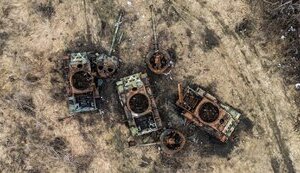Russia is running out of huge Soviet-era arms stockpiles - Economist

Russia has decommissioned its Soviet-era weapons, but up to 70 per cent of the old tanks have not been moved, and the rest have been laundered and passed off as new. According to most intelligence estimates, Russia lost about 3,000 tanks and 5,000 other armoured vehicles in the first two years of the war.
This is reported by The Economist, Censor.NET reports.
"The highly publicised Russian offensive on Kharkiv in the north, which began in May, has failed. Its advance elsewhere along the front line, especially in Donbas, was strategically trivial and achieved only at a huge cost. The question now is not so much whether Ukraine will be able to continue the fight, but how long Russia will be able to maintain its current pace of operations," the newspaper notes.
The journalists note that Russia can continue to recruit another 25,000 soldiers every month to maintain the number of troops at the front at around 470,000. In addition, Russia is rapidly increasing the production of missiles to strike Ukrainian infrastructure.
Soviet reserves are running out
"But for all the talk of Russia becoming a military economy, spending around 8% of its GDP on military expenditure, it can only replace the staggering losses of tanks, armoured infantry vehicles and artillery by pulling out of storage and restoring the stockpiles it accumulated during the Soviet era. While these stockpiles are huge, they are not unlimited," The Economist writes.
According to most intelligence reports, in the first two years of the great war, the Russians lost about 3,000 tanks and 5,000 other armoured vehicles. The Oryx intelligence website has obtained evidence of the destruction of 3,235 Russian tanks, but suggests that the real figure is "much higher".
Alexander Goltz, an analyst at the Stockholm Centre for East European Studies, believes that Russian dictator Vladimir Putin has the old Politburo to thank for the huge stockpiles of weapons accumulated during the Cold War.
Slowing down the pace of offensive operations
The biggest problem, however, is with tanks and infantry fighting vehicles, which are crucial for any large-scale offensive. While Russia may have had about 3,200 tanks in storage in February this year, IISS analyst Michael Jerstad noted that up to 70 per cent of them "have not moved since the war began".
Most of the T-72 tanks have been stored uncovered since the early 1990s and are likely in very poor condition. Experts believe that at the current rate of deterioration, Russia's tanks and infantry fighting vehicles in storage will reach a "critical point of depletion" by the second half of 2025.
According to Jerstad, if the situation does not change, the Russian army may have to change its stance to a more defensive one by the end of 2024. This may become apparent by the end of the summer.
The Economist concluded that Putin's interest in a temporary ceasefire will grow.
